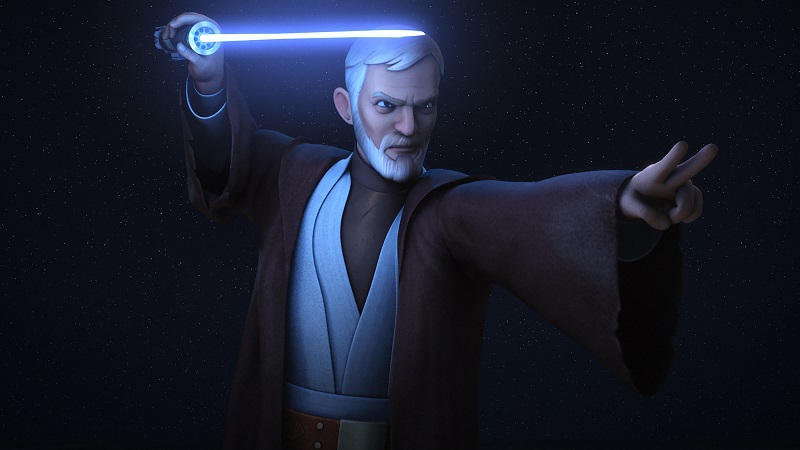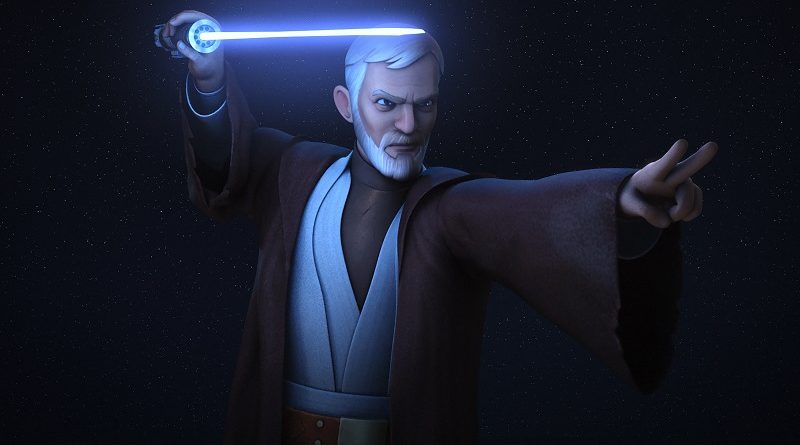Star Wars Rebels Twin Suns: Defining What It Means To Be a Jedi
 Darth Maul died in The Phantom Menace. Then The Clone Wars animated show came along, and George Lucas decided to play with our assumptions and resurrect a character who had engaged audiences in the Prequel Trilogy. To say that many fans were skeptical of Maul’s return perhaps doesn’t do justice to our reaction back then. Admittedly I threw side-eyes at the notion at first, too, but what came from the Maul-centric stories are some of my favorites. In his life after Obi-Wan halved him, we journeyed to Dathomir and met Mother Talzin and the Nightsisters. More importantly our understanding of the Force and who uses it began to expand as Force magick played into Maul’s second chance at life. Tonight, in the Star Wars Rebels episode “Twin Suns,” we learned about what it means to be a Jedi through the story of Maul’s death.
Darth Maul died in The Phantom Menace. Then The Clone Wars animated show came along, and George Lucas decided to play with our assumptions and resurrect a character who had engaged audiences in the Prequel Trilogy. To say that many fans were skeptical of Maul’s return perhaps doesn’t do justice to our reaction back then. Admittedly I threw side-eyes at the notion at first, too, but what came from the Maul-centric stories are some of my favorites. In his life after Obi-Wan halved him, we journeyed to Dathomir and met Mother Talzin and the Nightsisters. More importantly our understanding of the Force and who uses it began to expand as Force magick played into Maul’s second chance at life. Tonight, in the Star Wars Rebels episode “Twin Suns,” we learned about what it means to be a Jedi through the story of Maul’s death.
After “Secret Cargo” I discussed the concept of character agency, which we get in spades during “Twin Suns.” Each character has a purpose driving his – or her, in the sole case of Hera, – decision-making process. As I noted in that article, agency isn’t necessarily about making good decisions, simply about making believable ones. “Twin Suns” frames Maul’s intention on satisfying his revenge-driven bid at Kenobi’s suffering against Obi-Wan Kenobi’s long-term agenda. In doing so, the objectives of Sith and Jedi are revealed as sometimes more alike than it might seem. Palpatine played the long con, in a very solitary way, in his quest to destroy the Jedi Order. Maul’s role in that grand scheme was cut short; in his resurgence, Maul loses his Darth title and plots power moves against his former master. And now General and Master Kenobi has become simply Ben Kenobi, the lone hermit in the desert playing the waiting game for the time to draw his ace card in the ultimate battle against the Sith Lord and his evil Empire.
The episode opens with Maul muttering, “Lost. I am lost.” as he struggles to find Kenobi, whom he believed dead until the close of Season Two. During The Clone Wars, Maul sought revenge on Darth Sidious with his brother at his side. Sidious made him pay dearly, slaying Savage Opress in their epic battle. Through the opening sequence we see that Maul is willing to inflict upon Ezra Bridger the same manipulation Darth Sidious did to him. It is the ultimate cycle of bullying, one that we humans understand easily when presented it in fiction. Bent on revenge, Maul embodies selfish intentions. Notably, Maul voice actor Sam Witwer played the Brother, an embodiment of selfishness, in The Clone Wars memorable Mortis arc that lays important groundwork for Lucas’ Force mythology.
Star Wars Rebels is the journey of Ezra Bridger, so the story quickly turns to where he is: at home on the Ghost, poignantly noted with the visual of the young Jedi-in-training asleep in his pajamas. Obi-Wan’s holographic message to the Jedi of the Order’s sundering calls to Ezra, quickly reminding the audience of Kenobi’s purpose, the thing that drives all his actions within the story: a new hope. Intent on finding Obi-Wan, as a new hope for their drive to save Lothal, Ezra implores his adoptive family to heed the sign from this message.
Each of the Ghost crew acts in the story with agency. Rex reminds us that Senator Organa has lied to the rebels about Kenobi’s death, a totally believable action given the stakes. Kanan cautions Ezra that “Maul was manipulating you” previously. Hera, having endangered her fellow rebels over a selfish need in “Hera’s Heroes,” plainly states how important Ezra is to the assault on Lothal; she needs Ezra to help them prepare for the mission to be a success. Despite all this, Ezra steals a trainer and flees, but before he does Chopper exerts his own agency and stows away with him.
The holocron pieces provide some neat moments with the Force as Ezra searches for Kenobi on Tatooine. He gets close, as the beautifully rendered settings recalls the visuals in the films. In the canyon, Ezra recognizes the trap, and the Tusken Raiders become fodder for Maul when the former Sith intervenes to save him. This action is only in service of Maul’s objective – to find Kenobi – just as Kenobi’s rescue of Luke in A New Hope serves his purpose of safeguarding the farmboy. As Ezra and Chopper embark across the desert, we also see imagery that calls back to the iconic image from The Force Awakens showing Rey and BB-8 with their backs to the audience on the sand dune. We also see Ezra’s walk across the vast windswept desert play out similarly to Finn’s trek across Jakku. These are the ways Star Wars Rebels teaches the next generation of fans about the language of Star Wars.
 Kenobi shows up when all hope is seemingly lost for Ezra, and he tells him something both Kanan and Hera already had: “You’re in the wrong place, Ezra Bridger.” Obi-Wan, the Jedi the Order sent to win their wars, states very plainly his new take on his role: “I have no intention of fighting him, though that seems inevitable now.” Instead of being a general, Obi-Wan choses to only pick up his weapon if he must. Arguably, Kenobi might even have been willing to let Maul walk away, up until the point he began to determine Obi-Wan’s true reasons for hiding like a “rat in the desert.”
Kenobi shows up when all hope is seemingly lost for Ezra, and he tells him something both Kanan and Hera already had: “You’re in the wrong place, Ezra Bridger.” Obi-Wan, the Jedi the Order sent to win their wars, states very plainly his new take on his role: “I have no intention of fighting him, though that seems inevitable now.” Instead of being a general, Obi-Wan choses to only pick up his weapon if he must. Arguably, Kenobi might even have been willing to let Maul walk away, up until the point he began to determine Obi-Wan’s true reasons for hiding like a “rat in the desert.”
What this episode does masterfully is make the theme about setting Ezra down his path, but in the context of a tale meant to take Maul out of the equation and wrap up loose ends created during The Clone Wars. Maul had to go so the story of the Force can continue, and Maul’s resurrection in animation undid closure for Obi-Wan in the film. Likewise, looking forward, at least now fans can rule out one backstory Snoke does not have. The higher level meta is that Maul’s story has manipulated Ezra away from his purpose in Star Wars Rebels, and Kenobi’s role in the story is to course-correct it.
Obi-Wan sends Ezra back to his family and pledges to “mend this old wound,” a nod to the title of an Infinities alternate universe comic that also brought a resurrected Maul to a fatal final end in the deserts near young Luke Skywalker. Ezra shows he is learning what it means to be a Jedi when he mounts the dewback and rides away, trusting Maul’s fate to Obi-Wan’s hand and the guidance of the Force.
The whole episode is about choice and purpose, selfishness and selflessness. For anyone surprised how the fight went down, I believe it happened perfectly. Show creator Carrie Beck makes the point about their storytelling intention beautifully in an extended Rebels Recon. Maul wanted to fight. Maul enjoyed the hunt. Maul was destruction. Obi-Wan, though, slayed his opponent in a way that shows he is the one who has mastered the Force. It took years and hard lessons learned, but he has accomplished it.
“Look what I have risen above. … If you define yourself by your power to take life, your desire to dominate, to possess, then you have nothing.”
~ Obi-Wan Kenobi
The beautiful moment comes when Obi-Wan holds Maul, showing him compassion in the same way he did his master Qui-Gon and the love of his life Satine, both killed by Maul. Obi-Wan had let go of his attachment in service of his purpose: to protect Luke. As Maul dies in Kenobi’s arms he asks, “Is it the Chosen One?” This is a reminder that the Jedi and Sith not only believe in the Force, but also some of the same prophecies. The natural assumption is that Maul and Kenobi are having the same conversation. Maul is simply asking about what gives Obi-Wan purpose. The Jedi is talking to a dying being when he says, “He is.” But we would be remiss in not heeding Kenobi’s advice to Ezra about the message from the holocron if we assume “it” and “he” are connected. Nor do I believe Maul is talking about the Chosen One avenging Obi-Wan and Maul; the “us” is Maul and his clan brother Savage Opress.
The episode closes with Jedi-in-training Ezra Bridger returning to the place Jedi Master Obi-Wan Kenobi had sent him – to his family – and with Obi-Wan watching over his ward Luke Skywalker, who isn’t training to be a Jedi yet but rather learning the values of hard work, familial bonds, and what it means to love and be loved in return. As the suns set on Tatooine, we see that the Jedi might have learned the lesson that will carry them into the future.
I definitely recommend this week’s Rebels Recon, which discusses the journey to telling this important story. The biggest take away is that sometimes less is more, but more importantly they really considered the consequences of this story up and down the timeline. I don’t write the reviews for Star Wars Rebels – that is handled by the very insightful Ross Brown – but this one is definitely in the top tier from Star Wars animation in my opinion.
- Hyperspace Theories: SKELETON CREW Ahoy! - December 29, 2024
- Hyperspace Theories: WICKED Part I Rises to the Moment - December 6, 2024
- Columbia’s Vader™ Collection Launches Dec 5 - November 27, 2024









